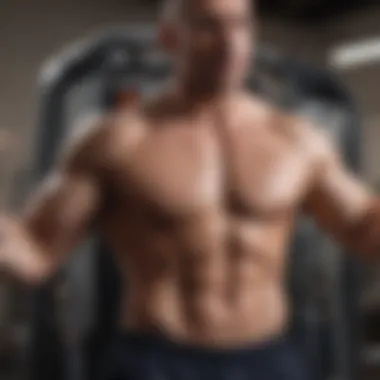Effective Chest Muscle-Building Exercises for Optimal Strength


Wellness
In the realm of physical health, focusing on exercises to enhance chest muscles is pivotal for overall strength training. The chest muscles, comprised of the pectoralis major and minor, play a crucial role in various upper body movements. By engaging in targeted exercises, individuals can effectively build and strengthen their chest muscles, contributing to improved posture and functional fitness.
Physical Health
Strengthening the chest muscles not only aids in better upper body mobility but also promotes overall stability and balance. Incorporating exercises like the bench press, push-ups, and chest flies can target different areas of the chest, ensuring comprehensive muscle development. Moreover, building chest muscles can decrease the risk of injuries during daily activities and other physical exercises.
Mental Health
The mental benefits of chest exercises stem from the release of endorphins, often referred to as 'feel-good' hormones. Engaging in a consistent workout routine that includes chest-focused exercises can boost mood, reduce stress, and enhance cognitive function. This connection between physical activity and mental well-being highlights the importance of incorporating chest exercises into one's fitness regimen.
Nutrition and Diet
Supporting chest muscle development goes beyond exercise; proper nutrition is equally essential. Consuming an adequate amount of protein, essential vitamins, and minerals aids in muscle recovery and growth. Incorporating lean proteins, whole grains, and vegetables into a balanced diet complements chest exercises, maximizing their effectiveness.
Fitness and Exercise
Fitness enthusiasts, whether beginners or experienced gym-goers, can benefit from a diverse range of chest exercises. From traditional movements like the dumbbell bench press to unconventional variations such as cable crossovers, exploring different techniques challenges the chest muscles in unique ways. Embracing a multifaceted approach to chest workouts transforms routine sessions into dynamic opportunities for growth and progress.
Importance of Chest Muscles


The chest muscles, also known as the pectoral muscles, play a crucial role in various upper body functions. These muscles are not only aesthetically important for a well-defined chest but are also essential for overall functional strength and posture. Strong pectoral muscles are vital for stabilizing the shoulder joints and enhancing the performance of daily activities that involve pushing or lifting objects. Additionally, well-developed chest muscles contribute to a balanced physique and can improve athletic performance.
Moreover, focusing on chest muscle development can lead to improved overall strength and muscular endurance, benefiting individuals engaged in various sports or physical activities. Strong chest muscles also aid in preventing shoulder injuries by providing support to the shoulder girdle during dynamic movements. As such, incorporating exercises targeting the chest muscles in a workout routine is beneficial not only for aesthetic purposes but also for enhancing functional strength and performance.
Furthermore, individuals looking to enhance their chest muscles must consider a balanced approach that includes both compound and isolation exercises. Compound exercises like bench presses target multiple muscle groups, including the chest, triceps, and shoulders, fostering overall upper body strength and muscle development. On the other hand, isolation exercises such as dumbbell flyes help in sculpting and defining the chest muscles while improving muscle symmetry and aesthetics. By understanding the importance of chest muscles and incorporating a variety of exercises into a training regimen, individuals can achieve comprehensive chest development and enhance their overall physical fitness.
Foundation Exercises
In the realm of chest muscle development, Foundation Exercises play a pivotal role in establishing a strong base for subsequent growth and strength gains. These exercises form the cornerstone of any effective chest workout regimen, ensuring overall muscle engagement and development. Foundation Exercises are fundamental movements that target multiple muscle groups, not just the chest, contributing to enhanced overall upper body strength and stability. By incorporating Foundation Exercises into your routine, you lay down the groundwork for advanced techniques and isolation exercises that follow.
Bench Press
The Bench Press stands tall as a classic and highly effective exercise for building chest muscles. It primarily targets the pectoralis major, anterior deltoids, and triceps, leading to significant muscle hypertrophy and strength gains. Performing the Bench Press with proper form and technique is critical to maximize its benefits and prevent injury. Ensure a controlled descent and powerful drive upwards, engaging your chest muscles throughout the movement. Variations like incline or decline bench presses can target different parts of the chest for more balanced development.
Push-Ups
Push-Ups, a bodyweight exercise, are often underestimated but are essential for chest muscle development. They engage not only the chest but also the shoulders, triceps, and core muscles, promoting overall upper body strength. Variations like diamond push-ups or wide-grip push-ups can target specific areas of the chest for a more defined look. Focus on maintaining a straight body line from head to heels during each repetition to ensure proper muscle activation and avoid strain on the lower back.
Dumbbell Flyes
Dumbbell Flyes are isolation exercises that primarily target the chest muscles, specifically the pectoralis major. Performing Flyes helps in stretching and contracting the chest muscles, leading to improved muscle definition and size. It is essential to perform Flyes with a controlled range of motion to reduce the risk of shoulder injury. Focus on squeezing your chest muscles at the top of the movement to enhance muscle activation and maximize growth.
Chest Dips


Chest Dips are excellent for targeting the lower chest muscles and triceps. By leaning slightly forward during the dip movement, you can emphasize the chest muscles' engagement for greater development. Use dip bars or parallel bars to perform this exercise with a full range of motion, lowering yourself until your upper arms are parallel to the floor. Chest Dips are advanced bodyweight exercises that require strength and stability but yield impressive results in chest muscle development.
Isolation Exercises
Isolation exercises play a pivotal role in this comprehensive guide for effective chest muscle development. These exercises target specific muscles in the chest without assistance from other muscle groups. By isolating the chest muscles, individuals can focus on enhancing strength and muscle definition in a more targeted manner. Isolation exercises are beneficial for individuals looking to refine and sculpt their chest muscles, particularly after completing foundation exercises. They aid in addressing muscle imbalances, enhancing muscle symmetry, and ensuring a well-rounded chest development.
Pec Deck Machine Flyes
Pec Deck Machine Flyes are a valuable addition to any chest workout routine. This exercise primarily targets the pectoralis major muscles, emphasizing muscle contraction throughout the movement. By using a pec deck machine, individuals can isolate the chest muscles effectively, minimizing engagement of secondary muscle groups. Pec Deck Machine Flyes help in stretching and contracting the chest muscles fully, promoting muscle growth and chest definition. It is essential to maintain proper form and control throughout the exercise to reap maximum benefits and prevent strain or injury. Beginners can start with lighter weights and gradually increase the resistance as they become more proficient in executing the movement.
Cable Crossovers
Cable Crossovers are an excellent isolation exercise for targeting the inner chest muscles and enhancing muscle separation. This exercise involves crossing the cables in front of the body, creating tension in the chest muscles throughout the range of motion. Cable Crossovers offer a unique advantage of providing constant resistance, ensuring continuous muscle engagement during both the concentric and eccentric phases of the movement. By incorporating Cable Crossovers into the workout routine, individuals can improve chest muscle definition, strength, and endurance. It is crucial to adjust the cable pulley heights to align with the desired target area of the chest and maintain a controlled motion to optimize the efficacy of the exercise.
Single-Arm Dumbbell Press
Single-Arm Dumbbell Press is a unilateral exercise that targets the chest muscles individually, promoting muscle balance and coordination. This exercise helps in correcting strength imbalances between the right and left sides of the body. Single-Arm Dumbbell Press engages the stabilizer muscles in the chest and shoulders, enhancing overall muscle activation. By performing this exercise, individuals can improve muscular symmetry, core stability, and functional strength. It is important to execute the Single-Arm Dumbbell Press with proper form, avoiding momentum and focusing on controlled movements to maximize the effectiveness of the exercise. Beginners can start with lighter dumbbells and gradually progress to heavier weights as they advance in their fitness journey.
Advanced Techniques
In the realm of chest muscle development, the incorporation of advanced techniques plays a pivotal role in enhancing the effectiveness of workouts and achieving notable gains. These techniques, characterized by their strategic application and intensity, elevate standard exercises to a whole new level of challenge and growth. By delving into advanced techniques, individuals can break through plateaus, engage muscle fibers more comprehensively, and foster greater muscle hypertrophy. The integration of techniques like Pause Reps, Drop Sets, and Incline Push-Ups demands a sense of discipline, focus, and knowledge of individual limits to maximize results. While these techniques may not be suitable for beginners due to their intensity, they serve as valuable tools for intermediate and advanced fitness enthusiasts looking to push their limits and stimulate continuous muscle adaptation.
Pause Reps


Pause reps entail a deliberate pause or hold at the most challenging point of an exercise, typically during the midpoint or bottom position. This tactic enhances muscle tension and time under tension, fostering muscle fatigue and recruitment of muscle fibers that are usually less engaged. By incorporating pause reps into chest workouts, individuals can target specific areas of the chest with heightened focus, promoting greater muscle activation and development. Through controlled and deliberate pauses, individuals can overcome strength plateaus and encourage further strength and muscle growth. However, it is essential to maintain proper form and alignment during pause reps to minimize the risk of injury and ensure optimal muscle engagement.
Drop Sets
Drop sets, a favored technique among bodybuilders and fitness enthusiasts, involve performing a set of an exercise to failure, then swiftly reducing the weight and continuing the set until reaching failure once more. This method induces muscle fatigue and metabolic stress, driving muscle fibers to work to their full capacity and beyond. Drop sets promote muscle endurance, enhance muscle pump, and stimulate muscle hypertrophy by pushing muscles to their limits and recruiting a wide spectrum of muscle fibers. Integrating drop sets into chest workouts can amplify the intensity of training sessions, leading to increased muscle engagement and growth over time.
Incline Push-Ups
Incline push-ups serve as an effective bodyweight exercise for targeting the upper chest region and enhancing overall chest definition. By elevating the feet on a bench or platform, individuals can increase the level of difficulty and resistance experienced during push-ups, leading to greater muscle activation in the upper chest area. This variation not only challenges the chest muscles but also engages stabilizing muscles in the core and shoulders, promoting functional strength and balance. Incline push-ups can be tailored to individual fitness levels by adjusting the height of the incline, allowing for progressive overload and continuous muscle adaptation. By incorporating incline push-ups into a regular workout routine, individuals can diversify their chest training, promote muscle symmetry, and work towards a more balanced and sculpted chest physique.
Tips for Optimal Chest Development
When it comes to sculpting a powerful and well-defined chest, incorporating effective tips for optimal chest development into your fitness routine is crucial. These tips serve as guiding principles that can significantly enhance the outcomes of your chest workouts. One key element to focus on is ensuring proper form and technique during exercises to target the chest muscles effectively. Maintaining strict form not only maximizes muscle engagement but also prevents injuries that could hinder your progress.
Another essential aspect to consider is the importance of progressive overload. To promote muscle growth and strength development in the chest region, gradually increasing the resistance or intensity of your workouts is essential. This progressive approach challenges your muscles, facilitating growth over time. Additionally, incorporating a diverse range of chest exercises into your training regimen is vital for comprehensive muscle development. By targeting the chest from various angles and incorporating different movements, you can ensure balanced muscle growth and avoid plateauing in your progress.
Moreover, paying attention to recovery and rest is paramount for optimal chest development. Adequate rest periods between workouts allow your muscles to repair and grow, leading to improved strength and muscle definition. While consistency is key in any fitness journey, listening to your body and allowing for sufficient recovery time is equally crucial for long-term progress and injury prevention.
Incorporating strategic nutrition into your chest development plan can also significantly impact your results. Ensuring proper protein intake to support muscle repair and growth, along with a balanced diet rich in essential nutrients, can optimize your chest development efforts. Hydration plays a vital role in muscle function and recovery, so maintaining adequate water intake is essential for overall performance and muscle health.
By combining these expert tips for optimal chest development with a well-rounded workout routine, proper nutrition, and adequate rest, you can effectively boost your chest muscle growth and strength. Implementing these strategies consistently and with dedication will contribute to sculpting a powerful and impressive chest physique that reflects your hard work and commitment to fitness excellence.
Conclusion
Furthermore, the conclusion serves as a testament to the holistic approach embraced in this article, amalgamating foundational exercises, isolation drills, and advanced techniques into a unified narrative of chest muscle enhancement. By delving into the nuances of each exercise category, readers are equipped with a diversified toolkit honed to cater to varying fitness levels and goals. This synthesis of exercises not only fosters muscular development but also cultivates a nuanced understanding of the multidimensional strategies underpinning chest muscle training. The conclusion acts as a compendium of wisdom, enabling readers to navigate through the maze of workout options with precision and purpose.
Moreover, the conclusion acts as a beacon of motivation and inspiration, instilling in readers a sense of empowerment and agency over their fitness journey. By distilling the complexities of chest muscle training into digestible nuggets of guidance, this section empowers individuals to embark on their path to a formidable chest with confidence and clarity. It underscores the significance of perseverance, consistency, and strategic planning in realizing one's fitness aspirations while emphasizing the iterative nature of muscle development.
In essence, the conclusion serves as the linchpin of this article, weaving together disparate strands of exercise techniques, tips, and insights into a coherent fabric of knowledge. It is not merely a curtain call but a definitive statement on the transformative power of disciplined training and informed decision-making in sculpting a robust and well-defined chest. As readers internalize the key messages distilled in this conclusive segment, they are poised to embark on a purposeful and progressive chest muscle-building journey, fortified by actionable strategies and informed choices.



